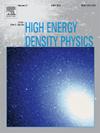Scalar-tensor corrections and observational signatures of hairy black holes in Horndeski gravity
IF 0.9
3区 物理与天体物理
Q3 PHYSICS, FLUIDS & PLASMAS
引用次数: 0
Abstract
We investigate specific physical properties of a previously derived hairy black hole solution in a particular Horndeski gravity model, focusing on observational signatures that might distinguish it from standard General Relativity (GR) solutions. Working with the metric function derived by Perez Bergliaffa et al., where represents the scalar hair parameter, we analyze its horizon structure and thermodynamic behavior. We demonstrate how the parameter modifies the Hawking temperature according to , with negative values suppressing temperature below the Schwarzschild baseline while positive values enhance it, potentially leading to altered evaporation processes compared to standard black holes. Using the Hamilton–Jacobi formalism modified by generalized uncertainty principle (GUP) considerations, we explore wave propagation and particle motion in this spacetime, deriving particle-dependent temperature corrections that introduce species-specific thermodynamic behavior. We derive analytical expressions for gravitational deflection angles in three distinct contexts: light rays in vacuum, electromagnetic waves in plasma, and massive particles, applying both the Gauss–Bonnet theorem and the Jacobi metric approach. For each case, we present explicit formulas showing the characteristic logarithmic terms introduced by the scalar hair, with plasma effects amplifying these signatures through frequency-dependent modifications. Through numerical analysis illustrated in our figures, we demonstrate how the scalar hair parameter influences the magnitude of these effects, revealing that negative values produce dramatically different phenomenology compared to positive values. Our entropy analysis reveals logarithmic corrections to the Bekenstein–Hawking area law consistent with quantum gravity predictions, supporting remnant formation scenarios that could resolve the information paradox.
Horndeski引力中毛状黑洞的标量张量修正和观测特征
我们在一个特殊的Horndeski引力模型中研究了先前导出的毛状黑洞解的特定物理性质,重点关注可能将其与标准广义相对论(GR)解区分开来的观测特征。利用Perez Bergliaffa等人导出的度量函数f(r)=1−2mr+hrlnr2m,其中h表示标量毛羽参数,我们分析了它的视界结构和热力学行为。我们论证了参数h如何根据TH=2m+h16πm2改变霍金温度,负值抑制史瓦西基线以下的温度,而正值则增强它,可能导致与标准黑洞相比蒸发过程的改变。利用经广义不确定性原理(GUP)修正的Hamilton-Jacobi形式,我们探索了波在该时空中的传播和粒子运动,推导了粒子相关的温度修正,引入了物种特有的热力学行为。本文应用高斯-博内定理和雅可比度量方法,推导了三种不同情况下重力偏转角的解析表达式:真空中的光线、等离子体中的电磁波和大质量粒子。对于每一种情况,我们都给出了显式公式,显示了标量毛发引入的特征对数项,等离子体效应通过频率相关的修改放大了这些特征。通过图中所示的数值分析,我们展示了标量毛发参数如何影响这些效应的大小,揭示了负h值与正值相比产生的显着不同的现象学。我们的熵分析揭示了贝肯斯坦-霍金面积定律的对数修正与量子引力预测一致,支持可以解决信息悖论的残余形成场景。
本文章由计算机程序翻译,如有差异,请以英文原文为准。
求助全文
约1分钟内获得全文
求助全文
来源期刊

High Energy Density Physics
PHYSICS, FLUIDS & PLASMAS-
CiteScore
4.20
自引率
6.20%
发文量
13
审稿时长
6-12 weeks
期刊介绍:
High Energy Density Physics is an international journal covering original experimental and related theoretical work studying the physics of matter and radiation under extreme conditions. ''High energy density'' is understood to be an energy density exceeding about 1011 J/m3. The editors and the publisher are committed to provide this fast-growing community with a dedicated high quality channel to distribute their original findings.
Papers suitable for publication in this journal cover topics in both the warm and hot dense matter regimes, such as laboratory studies relevant to non-LTE kinetics at extreme conditions, planetary interiors, astrophysical phenomena, inertial fusion and includes studies of, for example, material properties and both stable and unstable hydrodynamics. Developments in associated theoretical areas, for example the modelling of strongly coupled, partially degenerate and relativistic plasmas, are also covered.
 求助内容:
求助内容: 应助结果提醒方式:
应助结果提醒方式:


